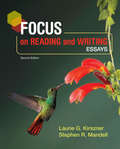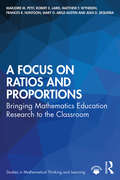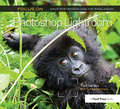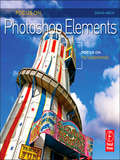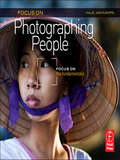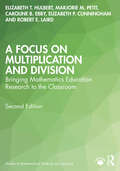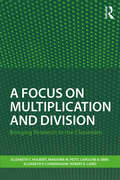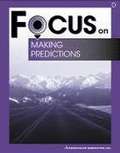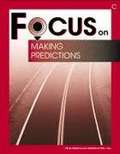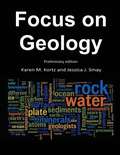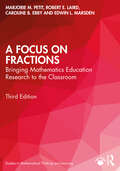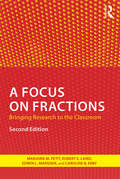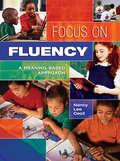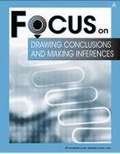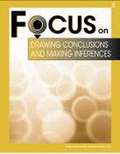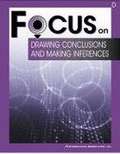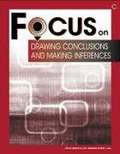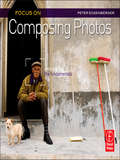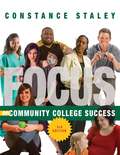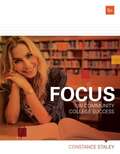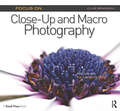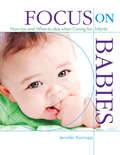- Table View
- List View
Focus on Reading and Writing: Essays
by Laurie Kirszner Stephen MandellMake the connection between the reading and writing processes as Focus on Reading and Writing helps you read and write essays by applying concepts to your own work.
A Focus on Ratios and Proportions: Bringing Mathematics Education Research to the Classroom (Studies in Mathematical Thinking and Learning Series)
by Marjorie M. Petit Robert E. Laird Matthew F. Wyneken Frances R. Huntoon Mary D. Abele-Austin Jean D. SequeiraThis resource offers a groundbreaking effort to make mathematics education research on ratios and proportions readily accessible and understandable to preservice and in-service teachers of grades 6 to 8. Using extensive annotated samples of student work and based on research gathered in the Ongoing Assessment Project (OGAP), A Focus on Ratios and Proportions teaches readers how students develop understanding and fluency involving ratio and proportion concepts. Special features include: A close focus on student work, including 150+ annotated pieces of student work, to help teachers improve their ability to recognize, assess and monitor their students’ errors and misconceptions, as well as their developing conceptual understanding. A focus on the OGAP Ratios and Proportions Progression, based on research conducted with hundreds of teachers and thousands of pieces of student work. Sections on how Common Core State Standards for Math (CCSSM) are supported by math education research. Student work samples and vignettes to illuminate the research, as well as end of chapter Looking Back questions and Instructional Links, which allow teachers to analyze evidence of student thinking and strategies and consider instructional responses. An accompanying eResource, available online, offers an answer key as well as extensive explanation of the Looking Back questions. Like A Focus on Multiplication and Division and A Focus on Fractions, this book is designed to bridge the gap between what math education researchers know and what teachers need to know in order to better understand evidence in student work and make effective instructional decisions.
Focus On Photoshop Lightroom: Focus on the Fundamentals (The Focus On Series)
by Dave Stevenson Nik RawlinsonCompatible with all versions of Lightroom Unsure where to start with Photoshop Lightroom? Feeling daunted by other 600 page monster user guides? Want to learn how to get the best out of your photography with the program in a snap? Focus on Photoshop Lightroom teaches you how to stay organized by using Lightroom’s industry-standard keywording and captioning features, bring out the very best in your photography with the processing module, and how to create image presets that make polishing a series of images quick and easy. Expert photographers and Lightroom users Dave Stevenson and Nik Rawlinson lead you through the ins and outs of the program with easy-to-follow steps and projects to get your creative juices flowing! Discover time-saving features and shortcuts to navigate Lightroom’s deceptively simple interface. Learn how to use the different Lightroom modules: how to import, organize, and sort your photos, edit them, create a book, video clips, or a slideshow, and how to make a great print! Be inspired by gorgeous photography and editing tips and tricks.
Focus On Photoshop Elements: Focus on the Fundamentals (The Focus On Series)
by David AschAre you bewildered by the advanced editing options available in Photoshop Elements? Do you want to get the most out of your image without going bleary-eyed in front of a computer screen? This handy guide will explain the ins and outs of using Photoshop Elements, without having to spend hours staring at the screen. Using a fabulous combination of easy-to-follow advice and step-by-step instructions, Focus On Photoshop Elements gives great advice on setting up, storing and sharing your image library and teaches you the basics of RAW image processing and color correction, plus shows you how to edit and retouch your images for stunning results. These simple tweaks and adjustments will take your images from so-so to amazing - and fast! Packed with inspiring photographs, this guide focuses on your needs as a photographer and nothing else.
Focus On Photographing People: Focus on the Fundamentals (The Focus On Series)
by Haje Jan KampsTaking good photographs of people is a combination of many factors: What is the best light for the subject? How should they stand? What aperture should you use for maximum impact? This easy-to-follow, highly visual guide to portraiture explains the technical and aesthetic considerations of creating great images. Step-by-step instruction, tips from an experienced professional photographer, project assignments and gorgeous photography make learning how to take good photos of people quick and easy. Aimed at beginners or amateurs toting a DSLR and wanting pointers on how to make their people photography really shine, this book offers the basics on composition, lighting, posing, street photography and post-production techniques in a fun andconversational manner.
A Focus on Multiplication and Division: Bringing Mathematics Education Research to the Classroom (Studies in Mathematical Thinking and Learning Series)
by Elizabeth T. Hulbert Marjorie M. Petit Caroline B. Ebby Elizabeth P. Cunningham Robert E. LairdThe second edition of this book offers a unique approach to making mathematics education research on the teaching and learning of multiplication and division concepts readily accessible and understandable to preservice and in-service K-6 mathematics teachers. Revealing students’ thought processes with extensive annotated samples of student work and vignettes characteristic of classroom teachers’ experience, this book provides teachers a research-based lens to interpret evidence of student thinking, inform instruction, and ultimately improve student learning. Based on research gathered in the Ongoing Assessment Project (OGAP) and updated throughout, this engaging and easy-to-use resource also features the following: New chapters on the OGAP Multiplicative Reasoning Framework and Learning Progressions and Using the OGAP Multiplicative Progression to inform instruction and support student learning In-chapter sections on how Common Core State Standards for Math are supported by math education research Case Studies focusing on a core mathematical idea and different types of instructional responses to illustrate how teachers can elicit evidence of student thinking and use that information to inform instruction Big Ideas frame the chapters and provide a platform for meaningful exploration of the teaching of multiplication and division Looking Back Questions at the end of each chapter allow teachers to analyze student thinking and to consider instructional strategies for their own students Instructional Links to help teachers relate concepts from each chapter to their own instructional materials and programs Accompanying online Support Material that includes an answer key to Looking Back questions, as well as a copy of the OGAP Fraction Framework and Progression A Focus on Multiplication and Division is part of the popular A Focus on . . . collection, designed to aid the professional development of preservice and in-service mathematics teachers. As with the other volumes on addition and subtraction, ratios and proportions, and fractions, this updated new edition bridges the gap between what math education researchers know and what teachers need to know to better understand evidence in student work and make effective instructional decisions.
A Focus on Multiplication and Division: Bringing Research to the Classroom (Studies in Mathematical Thinking and Learning Series)
by Elizabeth T. Hulbert Marjorie M. Petit Caroline B. Ebby Elizabeth P. Cunningham Robert E. LairdA Focus on Multiplication and Division is a groundbreaking effort to make mathematics education research readily accessible and understandable to pre- and in-service K–6 mathematics educators. Revealing students’ thought processes with extensive annotated samples of student work and vignettes characteristic of teachers’ experiences, this book is sure to equip educators with the knowledge and tools needed to modify their lessons and to improve student learning of multiplication and division. Special Features: Looking Back Questions at the end of each chapter allow teachers to analyze student thinking and to consider instructional strategies for their own students. Instructional Links help teachers relate concepts from each chapter to their own instructional materials and programs. Big Ideas frame the chapters and provide a platform for meaningful exploration of the teaching of multiplication and division. Answer Key posted online offers extensive explanations of in-chapter questions. Each chapter includes sections on the Common Core State Standards for Mathematics and integrates the Ongoing Assessment Project (OGAP) Multiplicative Reasoning Progression for formative assessment purposes. Centered on the question of how students develop their understanding of mathematical concepts, this innovative book places math teachers in the mode of ongoing action researchers.
Focus On Middle School Biology Student Textbook, 3rd Edition (Real Science-4-kids Ser.)
by Rebecca W. KellerThe Focus On Middle School Biology Student Textbook, 3rd Edition introduces young students to the scientific discipline of biology. Students will learn about philosophical maps, taxonomy, tools used in biology labs and fieldwork, microscopes, the chemistry of living things, the different types of cells, viruses, bacteria, archaea, protists, fungi, plant structures and reproduction, photosynthesis, animal cells and structures, non-chordates, mammals and other chordates, human anatomy, and more. The Focus On Middle School Biology Student Textbook, 3rd Edition has 16 full-color chapters and a glossary-index with pronunciation guides. 214 pages. Grades 5-8.
Focus on Making Predictions: Book D
by Curriculum AssociatesFill a comprehension skill gap with brief instruction and concentrated practice. Each skill book includes modeled instruction, guided and independent practice. Students answer selected- and constructed-response questions.
Focus on Making Predictions: Book C
by Curriculum AssociatesFill a comprehension skill gap with brief instruction and concentrated practice. Each skill book includes modeled instruction, guided and independent practice. Students answer selected- and constructed-response questions.
Focus On Geology Preliminary Edition
by Karen Kortz Jessica SmayThis Physical Geology textbook uses cutting edge research to guide the creation of carefully structured pages that cover topics commonly taught in introductory physical geology courses. The book is focused around images and emphasizes the key concepts Research (e.g. Mayer, 2003) indicates that students learn more deeply: - when extraneous material is excluded rather than included, - from words and pictures than from words alone, - when printed words are placed near rather than far from corresponding pictures, and - when words are presented in conversational rather than formal style. Most traditional geoscience textbooks do not address this research. Although geoscience textbooks are image-rich, the text is often separate from figures, generally with a note in the text referring the student to look at the image. Research indicates that many students just glance at the images or ignore them altogether, resulting in a less productive learning experience than intended by the authors. Also, most textbooks, even "essentials" versions, tend to have more information than an introductory student can learn in a semester, and the students, therefore, have a difficult time distilling the key concepts from the details. Images play an integral role in the textbook. There are no long blocks of text to read, but, instead, most information is presented incorporated in or around figures. Students therefore examine the images, integrating text and figures, which results in a deeper learning experience. Concepts are represented in multiple ways (photographs, written descriptions, detailed drawings, sketches, graphs, analogies, etc.) to maximize student learning. Because research indicates that students have a difficult time pulling out the key points from images, many of the images in this book are simple, without too many realistic-but-distracting details. Many of the photographs are accompanied by a simplified sketch of the same area illustrating the important geological features shown. The process of comparing two images presenting the same information in different ways (e.g. a photograph and a sketch) directs students to observe the important features and requires students to integrate those two images, strengthening their learning. Simple language is used when writing, and non-essential vocabulary words are omitted, so students will not focus on memorizing definitions without understanding the concepts. The book has a more conversational style than many current textbooks. This textbook presents the key concepts in geoscience without additional distracting details. As a result, this book is shorter than other books currently on the market. The concise nature of the book encourages students to read it. Because it emphasizes the key concepts, students have a better understanding of the fundamentals and will come to class more prepared. Therefore, instructors will be able to cover additional information in class, because the fundamentals are already understood by the students. The themes in the book are plate tectonics, water cycle, rock cycle and how geology and people affect each other. These are concepts that are key in understanding geoology and learning why it is relevant in today's society. These three themes are emphasized, and individual topics are related back to the overarching themes.
A Focus on Fractions: Bringing Mathematics Education Research to the Classroom (Studies in Mathematical Thinking and Learning Series)
by Marjorie M. Petit Robert E. Laird Caroline B. Ebby Edwin L. MarsdenThe third edition of this book offers a unique approach to making mathematics education research on the teaching and learning of fraction concepts readily accessible and understandable to pre-service and in-service K-8 mathematics teachers. Revealing students’ thought processes with extensive annotated samples of student work and vignettes characteristic of classroom teachers’ experience, this book provides teachers a research-based lens to interpret evidence of student thinking, inform instruction and ultimately improve student learning. Based on research gathered in the Ongoing Assessment Project (OGAP), and updated throughout, this engaging and easy-to-use resource also features: Two new chapters dedicated to understanding the OGAP Fraction Framework and Progression—based on research conducted with hundreds of teachers—to gather and interpret evidence of student learning along a learning progression, referenced throughout the book so readers can apply the concepts to their instruction; A close focus on student work, including 180+ annotated pieces of student work, to help teachers improve their ability to recognize, assess, and monitor their students’ errors and misconceptions, as well as their developing conceptual understanding; A discussion of decimal fractions, also new to the third edition; In-chapter sections on how Common Core State Standards for Math (CCSSM) are supported by math education research; End-of-chapter Looking Back questions to allow teachers to analyze student thinking and consider instructional strategies for their own students; Instructional links to help teachers relate concepts from each chapter to their own instructional materials and programs; Accompanying online Support Material includes an answer key to Looking Back questions, as well as a copy of the OGAP Fraction Framework and Progression. A Focus on Fractions is part of the popular A Focus on . . . collection, designed to aid the professional development of pre-service and in-service mathematics teachers. As with the other volumes on addition and subtraction, ratios and proportions, and multiplication and division, this updated new edition bridges the gap between what math education researchers know and what teachers need to know in order to better understand evidence in student work and make effective instructional decisions.
A Focus on Fractions: Bringing Research to the Classroom (Studies in Mathematical Thinking and Learning Series)
by Marjorie M. Petit Robert E. Laird Edwin L. Marsden Caroline B. EbbyA Focus on Fractions is a groundbreaking effort to make the mathematics education research on how students develop their understanding of fraction concepts readily accessible and understandable to pre- and in-service K– 8 mathematics educators. Using extensive annotated samples of student work, as well as vignettes characteristic of classroom teachers’ experiences, this book equips educators with the knowledge and tools to reveal students’ thinking so that they can modify their teaching and improve student learning of fraction concepts. A Focus on Fractions 2nd edition includes sections on the Common Core State Standards for Mathematics and the Ongoing Assessment Project (OGAP) Fraction Framework integrated into each chapter as well as a new chapter on the OGAP Fraction Progression and how it can be used for formative assessment purposes. This updated edition assists teachers in translating research findings into their classroom practice by conveying detailed information about how students develop fraction understandings. Additional images and examples serve to flesh out and supplement the newly-introduced concepts in this updated and expanded edition. Special Features: Looking Back Questions at the end of each chapter provide teachers the opportunity to analyze student thinking and consider instructional strategies for their own students. Instructional Links help teachers relate concepts from the chapter to their own instructional materials and programs. Big Ideas frame the chapters and provide a platform for meaningful exploration of the teaching of fractions. Answer Key posted online offers extensive explanations of in-chapter questions. New sections devoted to the CCSSM and OGAP Fraction Progression are woven throughout the book as well as a new stand alone chapter on the OGAP Fraction Progression. The OGAP Fraction Framework is an all-new eResource, now available as a free download from the book’s website: www.routledge.com/9781138816442.
Focus On Food Photography for Bloggers: Focus on the Fundamentals (The Focus On Series)
by Matt ArmendarizSharing your kitchen concoctions on your personal food blog has never been as popular as it is right now, but if you've ever had trouble getting your tasty temptations to look like pretty plates on camera, you know how difficult it can be to take amazing pictures of food. Matt Armendariz, of Mattbites food blog fame, shares his experiences and best practices for creating wonderful food photos in Focus On Food Photography for Bloggers. Written specifically for you the blogger, Matt discusses the ins and outs of equipment, lighting, composition, propping, sparking your inspiration, and getting creative, all with what you have on hand at home! Learn how to avoid common pitfalls with foods that are notoriously camera shy, how to successfully snap your dinner at a restaurant as well as on your kitchen table, and how to style your food with what you have in your cupboards. He also includes advice on post-processing, posting, and protecting your prized images. As well as on his blog, Matt's photography has been featured in The Skinny Bitch Cookbook, on Martha Stewart, Paula Deen's Best Dishes, and Gordon Ramsay's Hell's Kitchen, along with numerous food magazines and newspapers. Let this seasoned blogger give your food photography the boost it needs to really make your readers salivate!
Focus on Fluency: A Meaning-Based Approach
by Nancy L CecilThis valuable book is written for preservice and inservice teachers who are searching for best practices with which to promote fluency in reading and writing. Fluency is one of the primary building blocks for creating successful readers and writers, and the practical discussions and activities found here will help teachers develop effective ways to promote fluency and to engage and motivate children, while always remembering that the essential purpose of reading is to gain meaning from text and that of writing is to convey meaning through text.
Focus on Drawing Conclusions and Making Inferences: Book A
by Curriculum AssociatesFill a comprehension skill gap with brief instruction and concentrated practice. Each skill book includes modeled instruction, guided and independent practice. Students answer selected- and constructed-response questions.
Focus on Drawing Conclusions and Making Inferences: Book B
by Curriculum AssociatesFill a comprehension skill gap with brief instruction and concentrated practice. Each skill book includes modeled instruction, guided and independent practice. Students answer selected- and constructed-response questions.
Focus on Drawing Conclusions and Making Inferences: Book D
by Curriculum AssociatesFill a comprehension skill gap with brief instruction and concentrated practice. Each skill book includes modeled instruction, guided and independent practice. Students answer selected- and constructed-response questions.
Focus on Drawing Conclusions and Making Inferences: Book C
by Curriculum AssociatesFill a comprehension skill gap with brief instruction and concentrated practice. Each skill book includes modeled instruction, guided and independent practice. Students answer selected- and constructed-response questions.
Focus On Composing Photos: Focus on the Fundamentals (The Focus On Series)
by Peter EnsenbergerAs digital cameras and software packages become more advanced, seemingly by the minute, it has become easier than ever to overlook the basic elements which have always resulted in the best photographs, no matter how fancy (or primitive) the camera itself. Composition is the single most important aspect of creating great images, no matter what level of photographer you happen to be. No amount of digital wizardry can turn a badly composed image into a picture you would want to display. While many books on composition tend to overcomplicate the subject, this book breaks down everything you need to know into small, digestible chunks of information that you will actually remember once you're out and about taking pictures. Instead of plodding through long and complex pages of text, this book supplements the necessary information, such as the basics of the rule of thirds and how to get good highlights and shadows, with tons of gorgeous, full color images that actually show you what to do and how to do it, rather than just telling you what to try. You'll be amazed at the gorgeous images you'll create, whether your passion is for photographing your family, pets, travel adventures, nature, or anything else.
Focus on Community College Success (3rd Edition)
by Constance StaleyFOCUS ON COMMUNITY COLLEGE SUCCESS 3e speaks directly to the community college student, delivering strategies for navigating the unique challenges of juggling school, family, and work, and living/studying at home. Updated with the most current research, this forward-thinking text continues to strive to improve student retention, motivation, and engagement as well as offer proof of student progress and course efficacy through the Entrance and Exit Interviews. The THIRD EDITION includes expanded coverage of multitasking throughout the book with more strategies for helping students reduce distractions and focus on important tasks. A new section on Academic Professionalism defines what it means to be a professional student and shows students how they can build a positive reputation in the classroom. Staley, a leader in the field of motivation, helps students develop realistic expectations of what it takes to learn while encouraging and engaging them with direct applications and immediate results.
Focus on Community College Success
by Constance StaleyThis book is different. It won't coerce, coddle, caution, or coax you. Instead, it will give you the tools you need to coach yourself. Ultimately, this book is about you, your college career, and your career beyond college. It's about the future you will create for yourself.
Focus on Community College Success (Mindtap Course List Series)
by Constance StaleyNow in its 5th Edition, this book gives new students the tools, tenacity, and confidence to succeed in college and beyond! Packed with strategies that help community college students break through the special challenges of juggling school, family, and work, this resource propels students boldly into the future with activities that help them build the laser focus they need to cut through distractors, master coursework, transfer to four-year colleges, and achieve career goals. Updated with the latest, forward-thinking research from academic journals and practical career sources, this resource includes entrance and exit interviews to track academic growth, chapter content on managing personal finances, advice for career planning, and more, along with the MindTap learning platform that makes students unstoppable! New for 2021: Empower your students to connect the dots between what they’re learning now and their current or future careers with “How Transferable Are Your Skills?” – a new MindTap activity that challenges students to identify how their personal and academic experiences can help them become career-ready.
Focus On Close-Up and Macro Photography: Focus on the Fundamentals (The Focus On Series)
by Clive BransonWant to get the best out of your digital camera? Not quite sure how to capture up-close shots? Want easy to follow, expert advice on the best ways to creatively capture macro shots you can be proud of? This is your ticket to go beyond a snapshot to create a fine art print that you'll be so proud of. Macro and close-up photography involves a unique skill set in terms of exposure, lighting, and of course, composition in particular. You can take a quick photo of a sunflower in your back yard that will look mundane and typical OR you could learn how to take a picture of just a part of it-up close-and create a work of art. Let this book be your guide!
Focus on Babies: How-tos and What-to-dos when Caring for Infants
by Jennifer KarnoppA beginner's primer to providing professional child care for infants! The elements of a quality learning environment are not the same for every age. What works for preschoolers does not always work for toddlers, and what might be appropriate for toddlers is not necessarily the best arrangement for infants. Complete with tips for creating a developmentally appropriate environment and experiences that stimulate infants' muscles and minds, Focus on Babies gives you the tools to craft a quality learning environment that's as unique as the needs of the babies in your care. In simple language, Focus on Babies explains how to plan and implement a program where infants will grow and thrive. Topics include:* Your role as the caregiver* Setting up your space* Daily planning * Child growth and development * Addressing multiple intelligences * Evaluating your program
